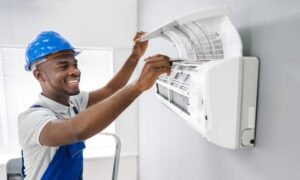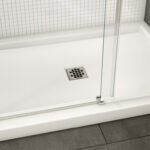Last updated on February 20th, 2024 at 05:41 am
Furnace maintenance is essential to a homeowner’s comfort and well-being. The air conditioner or furnace can be a major expense for homeowners, so it is important to keep it in good working order.
Regular furnace maintenance can prevent costly repairs down the road. Here are some furnace maintenance tips for keeping your furnace in good shape.
1. Clean Or Replace Your Filter
Most people don’t think about their furnace filters until they start having problems with their furnaces. It’s important to remember to replace or clean your filter regularly though, as it can help keep your furnace running smoothly.
A dirty filter can cause the furnace to work harder than necessary, which can lead to increased energy bills and possible system failure.
If you’re not sure when you last replaced your filter, or if it’s been a while since you’ve cleaned it, it’s a good idea to do so now. Replacing a dirty filter is a quick and easy task, and it can save you money in the long run. If your filter is severely clogged, however, it may be best to just replace it altogether.
2. Make Sure Blower Motor Is Functioning Correctly
During furnace maintenance, it is important to check that the blower motor is functioning correctly. If the blower motor is not working, the furnace will not be able to distribute heat throughout the house. In addition, a malfunctioning blower motor can increase your energy costs.
To ensure that the blower motor is working correctly, you should check the belt for tightness and inspect the fan blades for damage. If you notice any problems with the blower motor, you should contact a technician like Ultimate Plumbing And HVAC to have it repaired.
3. Reduce Home’s Heating Load

One of the best ways to reduce your home’s heating load is to have your furnace serviced regularly. A well-maintained furnace will run more efficiently, which will save you money on your energy bills. You can also take some simple steps to reduce the amount of heat your home loses through its windows and doors.
Installing insulation in your attic and weather stripping around your doors and windows are two easy ways to keep the heat in. You can also install window shades or blinds to help keep the heat out during the summer months.
4. Make Sure All Household Vents Are Free
One of the best ways to keep your furnace running smoothly is to make sure all the household vents are free. If they’re not, the furnace will have to work harder to push the air through, and that can lead to problems down the road.
It’s a good idea to check your vents periodically, especially during the fall and winter when you’re using your furnace more often. You can do this by walking around your house and checking for any blockages.
If you find any blocked vents, try clearing them out with a vacuum cleaner or a broom. Be careful not to damage the vent in any way, and make sure you don’t block it again after you’ve cleared it out.
If there are any areas of your house where the vents are difficult to reach, you may want to consider hiring a professional to clean them for you.
5. For Gas Furnaces, Verify The Exhaust Flue To The Outside Is Clear
Winter is a great time to take care of your furnace before it’s needed to keep you warm. One important task is to check the exhaust flue to make sure it’s clear.
This is important for two reasons: first, carbon monoxide can escape if the flue is blocked; and second, the furnace will not work properly if the flue is blocked.
To check the exhaust flue, go outside and look up at the chimney. If you can see snow or ice blocking the opening, use a shovel or an auger to clear it out.
Be careful not to let any of the debris fall into the chimney. You should also check inside the house to make sure there’s no blockage in the exhaust pipe that goes through the wall.
6. Remove All Flammable Objects From Around Your Furnace

Your furnace is a key part of your home during the winter. It’s important to make sure that all flammable objects are removed from around it.
This includes anything made of cloth, paper, or wood. If something were to catch on fire near your furnace, it could easily spread to the rest of your home.
Be sure to check the area around your furnace regularly for any flammable objects. If you have any questions about what can and can’t be around your furnace, contact a professional technician. They will be able to help you keep your home safe this winter.
7. Clean Your Heating Systems Vents And Ductwork
A build-up of dirt and dust in your heating system’s vents and ductwork can lead to decreased airflow and increased energy use. In severe cases, it can even cause the furnace to overheat.
To keep your heating system running at its best, be sure to clean the vents and ductwork regularly. The best way to clean the vents and ductwork is with a vacuum cleaner equipped with a hose attachment.
Be sure to remove as much of the build-up as possible, especially around the registers. If you have an attic or crawlspace, you may also want to check for insulation or other debris that may have been collected in the ductwork.
8. Start Your Maintenance Early
The best way to avoid a furnace emergency is by performing regular maintenance on your system. By starting your maintenance early, you can catch any small problems before they turn into big ones.
Your furnace is a major appliance in your home and should be treated as such. Routine maintenance will help ensure that it runs safely and efficiently all winter long.
Some of the tasks that should be performed as part of your regular maintenance routine include: checking the filters, cleaning the blower assembly and housing, checking the thermostat calibration, and lubricating all moving parts.
If you have a central air conditioning unit, it’s also important to check and clean the outdoor condenser unit at least once a year. Neglecting routine maintenance can lead to more expensive repairs down the road.
9. Inspect The Thermostat Wires
When you’re performing furnace maintenance, one of the key things you should inspect is the thermostat wires. These wires connect the thermostat to the furnace, and if they’re not in good condition, it can cause problems with the furnace.
One common problem is that the insulation on the wires can wear off, which can cause them to short out. This can lead to all sorts of problems with the furnace, including overheating and even a fire.
Another problem that can occur is that the wires can come loose. This can cause the furnace to stop working properly or even stop working altogether.
The best way to prevent these problems is to inspect the thermostat wires regularly and make sure they’re in good condition. If you notice any signs of damage or wear, replace them immediately.
10. Clean The Flame Sensor

Your furnace flame sensor is likely dirty if you are experiencing furnace problems. To clean the sensor, first, turn off the power to your furnace at the breaker. Next, remove the front cover of your furnace.
There will be a wire mesh guard in front of the flame sensor (which is just one of the many uses for wire cloth out there). Remove the screws that hold the guard in place and set it aside.
You can now reach the flame sensor and clean it with a brush or vacuum cleaner. Be sure to reattach the wire mesh guard when you are finished cleaning. Turn on the power to your furnace and check to see if it is working properly.
11. Inspect The Burner Flames
Inspecting the burner flames is an important part of furnace maintenance. If the flames are too high or too low, it can cause the furnace to work harder than necessary and lead to decreased efficiency and increased energy costs.
To inspect the burner flames, first make sure that the furnace is turned off and that there is no gas flowing to the unit. Then, remove the access panel on the front of the furnace and locate the burner.
The burner should have several small flames that are evenly spaced apart. If any of the flames are higher or lower than the others, it could indicate a problem with either the burner or the fuel supply.
If you notice any problems with the burner flames, be sure to call a qualified technician for assistance. Ignoring these problems can lead to increased energy costs and safety risks.
12. Remove The Blower To Clean It
One of the most important – but often neglected – tasks in furnace maintenance is cleaning the blower. Over time, dust and dirt can build up on the blades and around the housing, which can reduce airflow and increase energy consumption. To clean the blower, you’ll need to remove the housing and access the blades.
Disconnect the power to the furnace and find the screws or bolts that hold the housing in place. Remove them and set the housing aside. You should then be able to see the blades; use a brush or vacuum cleaner to clean off any dust or dirt.
If there is any built-up gunk on the blades, you can soak them in a degreaser or vinegar solution for a few hours before rinsing them off and reassembling everything.
Final Thought
In conclusion, it is important to properly maintain your furnace in order to ensure that it runs smoothly and efficiently all winter long.
By following these simple tips, you can keep your furnace in good shape and avoid costly repairs. Remember, prevention is always the best cure!
















